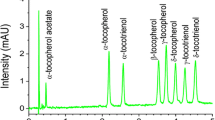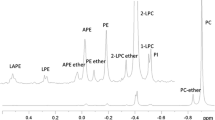Abstract
Squalene is sourced predominantly from shark liver oils and to a lesser extent from plants such as olives. It is used for the production of surfactants, dyes, sunscreen, and cosmetics. The economic value of shark liver oil is directly related to the squalene content, which in turn is highly variable and species-dependent. Presented here is a validated gas chromatography-mass spectrometry analysis method for the quantitation of squalene in shark liver oils, with an accuracy of 99.0 %, precision of 0.23 % (standard deviation), and linearity of >0.999. The method has been used to measure the squalene concentration of 16 commercial shark liver oils. These reference squalene concentrations were related to infrared (IR) and Raman spectra of the same oils using partial least squares regression. The resultant models were suitable for the rapid quantitation of squalene in shark liver oils, with cross-validation r 2 values of >0.98 and root mean square errors of validation of ≤4.3 % w/w. Independent test set validation of these models found mean absolute deviations of the 4.9 and 1.0 % w/w for the IR and Raman models, respectively. Both techniques were more accurate than results obtained by an industrial refractive index analysis method, which is used for rapid, cheap quantitation of squalene in shark liver oils. In particular, the Raman partial least squares regression was suited to quantitative squalene analysis. The intense and highly characteristic Raman bands of squalene made quantitative analysis possible irrespective of the lipid matrix.




Similar content being viewed by others
Abbreviations
- ATR:
-
Attenuated total reflectance
- CCD:
-
Charge coupled device
- DAGE:
-
Diacylglycerol ether
- GC:
-
Gas chromatography
- HPLC:
-
High performance liquid chromatography
- ICH:
-
International Conference on Harmonization of Technical Requirements
- IR:
-
Infrared
- MAD:
-
Mean absolute deviation
- MS:
-
Mass spectrometry
- MUFA:
-
Monounsaturated fatty acids
- NIPALS:
-
Non-iterative partial least squares
- PLS-R:
-
Partial least squares regression
- PUFA:
-
Polyunsaturated fatty acids
- RMSEC:
-
Root mean squared error of calibration
- RMSEV:
-
Root mean squared error of validation
- SNV:
-
Standard normal variate
- TAG:
-
Triacylglyerol
References
Popa O, Băbeanu NE, Popa I, Niţă S, Dinu-Pârvu CE (2015) Methods for obtaining and determination of squalene from natural sources. Biomed Res Int 2015:367202. doi:10.1155/2015/367202
Gopakumar K, Thankappan TK (1986) Squalene, its sources, uses, and industrial applications. Seafood Export J 18(3):17–21
Reddy LH, Couvreur P (2009) Squalene: a natural triterpene for use in disease management and therapy. Ad Drug Deliver Rev 61:1412–1426
Huang Z-R, Lin Y-K, Fang J-Y (2009) Biological and pharmacological activities of squalene and related compounds: potential uses in cosmetic dermatology. Molecules 14:540–554
Wetherbee BM, Nichols PD (2000) Lipid composition of the liver oil of deep-sea sharks from the Chatham Rise, New Zealand. Comp Biochem Physiol B 125:511–521
Bakes MJ, Nichols PD (1995) Lipid, fatty acid and squalene composition of liver oil from six species of deep-sea sharks collected in southern Australian waters. Comp Biochem Physiol B 110:267–275
Navarro-Garcia G, Pacheco-Aguilar R, Vallejo-Cordova B, Ramirez-Suarez J, Bolaños A (2000) Lipid composition of the liver oil of shark species from the Caribbean and Gulf of California waters. J Food Comp Anal 13:791–798
Deprez P, Volkman J, Davenport S (1990) Squalene content and neutral lipis composition of Livers from Deep-sea sharks caught in Tasmanian waters. Mar Freshw Res 41:375–387
Remme JF, Larssen WE, Bruheim I, Sæbø PC, Sæbø A, Stoknes IS (2006) Lipid content and fatty acid distribution in tissues from Portuguese dogfish, leafscale gulper shark and black dogfish. Comp Biochem Physiol B 143:459–464
Bone Q (1988) Muscles and locomotion. Physiology of elasmobranch fishes. Springer, Berlin
Russo A, Muzzalupo I, Perri E, Sindona G (2010) A new method for detection of squalene in olive oils by mass spectrometry. J Biotechnol 150:296–297
Guibert S, Batteau M, Jame P, Kuhn T (2013) Detection of squalene and squalane origin with flash elemental analizer and delta V isotope ratio mass spectrometer. Application Note 30276. http://www.hindawi.com/journals/bmri/2015/367202/cta/
Batista I, Nunes M (1992) Characterisation of shark liver oils. Fish Res 14:329–334
Chun HJ, Weiss TL, Devarenne TP, Laane J (2013) Vibrational spectra and DFT calculations of squalene. J Mol Struct 1032:203–206
Czamara K, Majzner K, Pacia M, Kochan K, Kaczor A, Baranska M (2015) Raman spectroscopy of lipids: a review. J Raman Spec 46:4–20
Baeten V, Dardenne P, Aparicio R (2001) Interpretation of Fourier transform Raman spectra of the unsaponifiable matter in a selection of edible oils. J Agric Food Chem 49:5098–5107
Baeten V, Fernández Pierna JA, Dardenne P, Meurens M, García-González DL, Aparicio-Ruiz R (2005) Detection of the presence of hazelnut oil in olive oil by FT-Raman and FT-MIR spectroscopy. J Agric Food Chem 53:6201–6206
Zou M-Q, Zhang X-F, Qi X-H, Ma H-L, Dong Y, Liu C-W, Guo X, Wang H (2009) Rapid authentication of olive oil adulteration by Raman spectrometry. J Agric Food Chem 57:6001–6006
Killeen DP, Sansom CE, Lill RE, Eason JR, Gordon KC, Perry NB (2013) Quantitative Raman spectroscopy for the analysis of carrot bioactives. J Agric Food Chem 61:2701–2708
Schrader B, Klump H, Schenzel K, Schulz H (1999) Non-destructive NIR FT Raman analysis of plants. J Mol Struc 509:201–212
Lanzón A, Guinda A, Albi T, de la Osa C (1995) Método rápido para la determinación de escualeno en aceites vegetales. Grasas Aceites 46:276–278
Validation of Analytical Procedures: Text and Methodology, International Conference on Harmonization 1995 http://www.ich.org/products/guidelines/quality/article/quality-guidelines.html. Accessed 22 Oct 2015
Lin-Vien D, Colthup NB, Fateley WG, Grasselli JG (1991) The handbook of infrared and Raman characteristic frequencies of organic molecules. Elsevier, Amsterdam
Acknowledgments
This research was supported by funding from the New Zealand Ministry for Business Innovation and Employment (MBIE) for the programme Export Marine Products (C11X1307) and the Dodd-Walls Centre. The authors would like to thank Michael Baird and Mark Gornall of Seadragon Marine Oils Ltd® for providing shark liver oil samples and information.
Author information
Authors and Affiliations
Corresponding author
Ethics declarations
Conflict of interest
The authors declare no conflict of interest.
About this article
Cite this article
Hall, D.W., Marshall, S.N., Gordon, K.C. et al. Rapid Quantitative Determination of Squalene in Shark Liver Oils by Raman and IR Spectroscopy. Lipids 51, 139–147 (2016). https://doi.org/10.1007/s11745-015-4097-6
Received:
Accepted:
Published:
Issue Date:
DOI: https://doi.org/10.1007/s11745-015-4097-6




